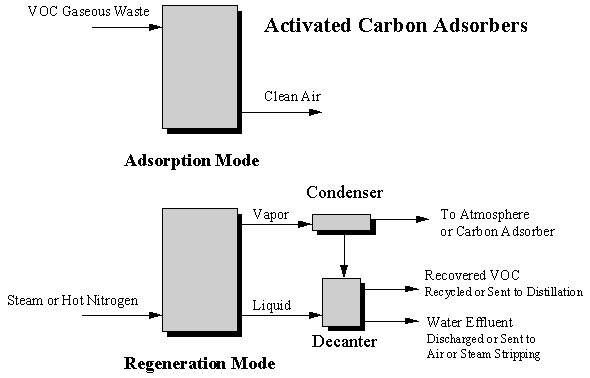Activated Carbon Adsorption
(Ruddy and Carroll, 1993; US EPA, 1991, Stenzel, 1993) |
Description
- VOC gaseous emissions flow into the top or bottom of an adsorption column, filled with
porous activated carbon, and is distributed throughout the carbon bed.
- Two adsorption processes exist, temperature-swing adsorption (TSA) and pressure-swing
adsorption (PSA). Temperature-swing adsorption is the approach commonly used for VOC
recovery and the process description, advantages, and disadvantages listed in this section
correspond to the temperature-swing adsorption process.
- Carbon adsorption beds can be fixed or moving, with respect to the carbon. For moving
beds, the flow of activated carbon is countercurrent to the flow of the gas; however,
fixed beds are more common in industry.
- The VOC is adsorbed onto the surface of the activated carbon and onto the surface of the
pores. At some point the carbon becomes saturated with VOC and loses its capacity for
additional adsorption. This results in the concept of "breakthrough" where
significant quantities of VOC become apparent in the gas stream exiting the adsorption
process. When this occurs the carbon must be regenerated for re-use or replaced with
virgin carbon.
- Multiple fixed beds are generally employed so that as one or more beds are adsorbing at
least one bed can be regenerating. Regenerating a bed of activated carbon typically
involves the direct injection of steam, hot nitrogen or hot air to the bed which causes
the VOC to release from the carbon and exit the bed via a vapor or condensate stream. The
regenerated stream, containing a higher concentration of the VOC than the original
wastewater stream, is subsequently condensed. If the VOC is immiscible in water, the
condensate will form an aqueous layer and a solvent layer that can be separated using a
decanter. If the VOC is miscible in water, additional distillation can be used to further
separate the VOC and water.
- "VOC-free" gas exits the adsorber after contacting the activated carbon.
Advantages
- A widely used technology with well established performance levels.
- Can achieve high recovery efficiencies (90-98%).
- Can be used for a wide range of gas flow rates (100-60,000 cfm).
- Can handle a wide range of inlet VOC concentrations (20-5,000 ppm).
- Can efficiently handle fluctuations in gas flow rates and VOC concentrations.
Disadvantages
- VOC's having high heats of adsorption (typically ketones) can cause carbon bed fires.
- Carbon attrition properties (permanent bonding of small quantities of VOC through each
adsorption cycle) requires the periodic replacement of carbon with virgin or reactivated
carbon. Spent carbon may need to be disposed of as a hazardous waste depending on the
VOC(s) adsorbed.
- Carbon efficiency decreases for high humidity (>50% r.h.) air streams.
|


